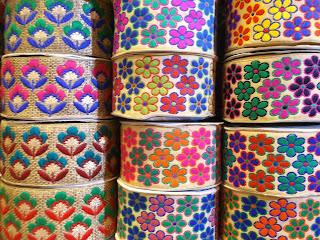Namaste ! (2)
Et voici quelques-uns des lieux que nous avons visités,
particulièrement intéressants du point de vue textile :
A Dehli: Kinari Bazar, une ruelle avec des douzaines
de magasins proposant des galons, des fils, des perles et des paillettes. Le
tout très brillant – nous sommes bien dans le pays de Bollywood !
A Ahmedabad: le Calico Museum – une collection
époustouflante de cotons imprimés, les plus anciens datant du quinzième siècle,
et de bouts de cotons provenant de fouilles archéologiques. Les photos ne sont
pas permises dans le musée, mais un peut toujours acheter un livre dans leur librairie… Dans la
même ville se trouve l’ashram de Mahatma Gandhi, où on commémore son habitude
de filer du coton à la main, en signe de protestation contre la domination britannique
de l’industrie du coton en Inde. Une jeune personne y file du coton sur le même
type de rouet que celui utilisé par Gandhi ; le fil est ensuite tissé en
un tissu nommé khadi, uni ou à rayures.
A Udaipur, il y a tout un quartier de boutiques
d’artisanat populaire. Celui où nous nous sommes arrêtées (Albeli) proposait,
entre autres, des objets brodés anciens de toute sorte, des morceaux récupérés sur
des vêtements usés, et également, du coton imprimé au mètre d’une légèreté et
d’une douceur incroyable !
A Jaipur, il y a le musée Anokhi, retraçant l’histoire
de l’impression sur coton et celle de l’entreprise, fondée par des hippies
occidentaux dans les années 1960 ; hmmm… ce que me rappelle que c’était en
1970 que j’ai acheté ma première tunique indienne, à Londres…..
(dernière photo: merci à Béatrice Compagnon)
Namaste ! (2)
Here are a few places
of particular interest to textile aficionados:
In Dehli, Kinari
Bazar: a narrow street with dozens of haberdashery shops, offering trims, embroidery floss, beads and sequins. It is all very sparkling - we are in Bollywood country,
to be sure!
In Ahmedabad, the
Calico Museum – a stunning collection of printed cotton cloth, some of the pieces
dating back as far as the fifteenth century, and cotton fragments from archaeological
sites. Photography is not allowed in the museum, but you can always buy a book in their shop … In the same town, you can visit Mahatma Gandhi’s ashram. Among other things, it
continues Gandhi’s habit of spinning cotton manually, which he did in protest
to the British domination of the Indian cotton industry. A young person is seen
spinning cotton on the same type of spinning wheel as that used by Gandhi; the
yarn is then woven into a fabric called khadi,
either solid or striped.
In Udaipur, there
is a whole district of craft shops. The one we stopped at (Albeli) stocked,
among other goods, all sorts of vintage embroidered pieces, and salvaged
fragments of garments. There is also printed cotton on the bolt to be had,
incredibly light and soft.
In Jaipur, the
Anokhi museum retraces the history of cotton printing and that of the company,
founded in the 1960s by western hippies; hmmm… that reminded that it was in 1970
that I bought my first Indian tunic, in London….









Aucun commentaire:
Enregistrer un commentaire